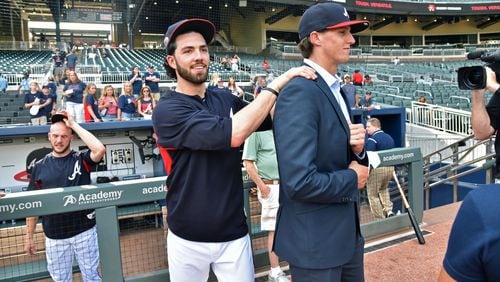Braves fans celebrated the 1-0 victory over Justin Verlander and Detroit in the final game of the 2016 season, which also was the final game staged at Turner Field. The men charged with shaping this club's future slept fitfully that October night. Had the Braves lost 2-1, they’d have picked second in the 2017 draft. By winning, they slid to fifth.
Maybe that doesn’t seem such a big deal to you, but baseball folks see it otherwise. The difference between No. 2 and No. 5 in 2013 was the difference between Kris Bryant, the 2016 National League MVP, and Clint Frazier, an outfielder from Loganville High who’s hitting .260 for Triple-A Scranton/Wilkes-Barre. (To be fair, Frazier – part of the Yankees’ haul for the great reliever Andrew Miller – is listed by MLB.com as the No. 2 prospect in baseball’s second-best farm system.)
It might have been different had the Braves had their eye on two or three prospects they deemed of equal value. But they didn’t. They wanted Kyle Wright, the junior right-handed pitcher from Vanderbilt. “We thought he was the best player in the draft,” general manager John Coppolella said Friday at a news conference to introduce Wright to the local audience, and they treated him as such. The Braves are paying the fifth player taken as if he’s the No. 1 of No. 1s.
Wright signed for $7 million, a record bonus under the slotting system. It eclipses the $6.7 million the Cubs bestowed on the aforementioned Bryant. The Braves went over-slot, as the terminology has it, to ensure their draftee would become a signee, which not every draftee does. (Brady Aiken, the 1-1 pick in 2014, famously spurned the Astros’ under-slot offer.)
There are two ways to know how much the Braves wanted Wright. One, duh, is the money. Paying him $7 million means less for other draftees. The team’s six picks in Rounds 5 through 10 were all what’s known as senior signs, meaning college players who have completed their eligibility and have no leverage. (A collegiate junior can return to school for a final season. A high schooler can choose college ball over the pros, but that’s a three-year commitment.)
The point being: The Braves tailored their draft around Wright. Last year they took Ian Anderson, a high school pitcher, No. 3 overall and signed him for under-slot money, using the savings to afford Joey Wentz and Kyle Mueller, high school pitchers picked 40th and 44th. The Braves’ 2016 draft was an accumulation of young arms. The 2017 edition was a grab -- but not a reach -- for an impact player.
“Kyle has proven himself more than Ian,” Coppolella said. “The further away you are (from the majors), the more risk there is. Kyle pitched in arguably the best conference in the nation. With the quantity we have, we felt it was the right move to go for quality.”
Coppolella said Wright will start in the Gulf Coast League, which is for rookies, the plan being to move him to Single-A Rome soon. Anderson stayed in rookie ball all last season; Kolby Allard, the high school pitcher taken 14th overall in 2015, did likewise in his Year 1. The Braves have set Wright on a faster track. Coppolella mentioned Mike Minor, the Vanderbilt pitcher the Braves took No. 7 overall in June 2009; by August 2010, he was in the majors. The GM also referenced Alex Wood, a Round 2 pick in 2012; his big-league debut came 11 months after his drafting.
This isn’t to suggest the Braves don’t love Anderson and Allard. (They do.) This is to state that Wright, who’s 21, is closer to the majors on his first day as a signed professional than any high schooler the Braves drafted in 2015 and 2016. He’s not just another promising arm in a farm system a-swim with arms. Said Coppolella: “He could start a playoff game for us.”
The other way to know how much the Braves coveted Wright: Scouting director Brian Bridges spent the winter and spring having kittens on a daily basis. “There was no doubt in my mind he was the best player in this draft,” Bridges said. “He changed his mechanics during the season (after a slow start), and my reaction was, ‘I wish he wouldn’t have.’ That made my life much harder. He gave up three unearned runs against South Carolina (on April 8), and I said, ‘That’s it; we’re done. We’re not getting this guy.’ ”
The Braves, see, were sold. Coppolella and Bridges had met with Wright in Nashville in January. A Braves scout saw every game he pitched. But Bridges kept thinking, “There’s no way in the world he’s there at No. 5.” Yet he was. And he’s from Huntsville, Ala., and he grew up a Braves fan and was a collegiate teammate of Face of the Franchise Dansby Swanson, who greeted Wright at SunTrust Park on Friday with a hug.
Funny how things work. After months of fretting, the Braves have Kyle Wright. Somehow it feels … inevitable.
Further reading: A conversation with Coppolella: The draft and Sean Newcomb.
Further still: Coppolella in conversation, Pt. 2: Colon, Swanson and Snitker.
About the Author







